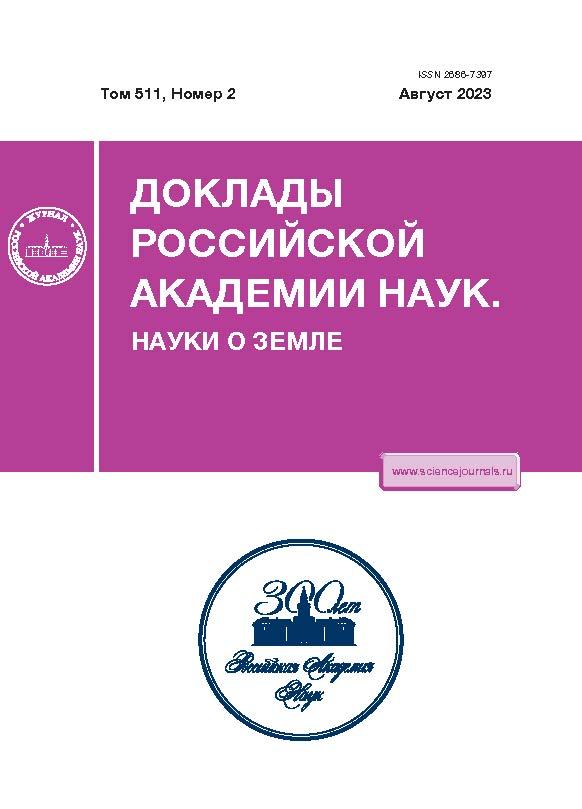CHANGES IN CONTENT AND COMPOSITION OF HYDROCARBONS IN THE BOTTOM SEDIMENTS OF THE NORILO-PYASINSK WATER SYSTEM A YEAR AFTER THE EMERGENCY DIESEL FUEL SPILL
- Autores: Nemirovskaya I.A.1, Glyaznetsova Y.S.2, Sokov A.V.1
-
Afiliações:
- Shirshov Institute of Oceanology, Russian Academy of Sciences
- Institute of Oil and Gas Problems, Siberian Branch of the Russian Academy of Sciences
- Edição: Volume 511, Nº 2 (2023)
- Páginas: 168-175
- Seção: GEOCHEMISTRY
- ##submission.dateSubmitted##: 30.01.2025
- ##submission.datePublished##: 01.08.2023
- URL: https://edgccjournal.org/2686-7397/article/view/649847
- DOI: https://doi.org/10.31857/S2686739723600571
- EDN: https://elibrary.ru/WFYCLU
- ID: 649847
Citar
Texto integral
Resumo
One year after the emergency diesel fuel spill in Norilsk, hydrocarbon concentrations in bottom sediments of the Norilo-Pyasinsky water system decreased. But on average in the areas they decreased in the same sequence (µg/g) as in 2020: the mouth of the Ambarnaya R. (835, σ = 1788) > Bezymyanny Cr. – the Daldykan R. – the Ambarnaya R. (306, σ = 273) > Pyasina R. (23, σ = 20) > Lake Pyasino (12, σ = 8). Concentrations decreased due to degradation of low molecular weight hydrocarbons. The content of polycyclic aromatic hydrocarbons in 2021 also changed in a smaller range (0–1027 ng/g) than in 2020 (0–3865 ng/g). Petroleum origin of hydrocarbons in the sediments of the Ambarnaya R. (including the mouth), Bezymyanny Cr. and Daldykan R. confirms the dominance of alkylated naphthalene homologues in their composition. Hydrocarbons accumulation in some horizons of the sedimentary strata is caused not only by seepage of diesel fuel, but also to the introduction of organic matter from the surrounding swamps from wetlands and floodplain lakes, as well as the burial of the surface layer by the 2021 flood.
Sobre autores
I. Nemirovskaya
Shirshov Institute of Oceanology, Russian Academy of Sciences
Autor responsável pela correspondência
Email: nemir44@mail.ru
Russian, Moscow
Yu. Glyaznetsova
Institute of Oil and Gas Problems, Siberian Branch of the Russian Academy of Sciences
Email: nemir44@mail.ru
Russian, Yakutsk
A. Sokov
Shirshov Institute of Oceanology, Russian Academy of Sciences
Email: nemir44@mail.ru
Russian, Moscow
Bibliografia
- Сазонов А.Д., Комаров Р.С., Передера О.С. Разлив нефтепродуктов в Норильске 29 мая 2020 года: предполагаемые причины и возможные экологические последствия // Экологические исследования и экологический мониторинг. 2020. № 1–5. С. 173–177.
- Трошко К.А., Денисов П.В., Лаврова О.Ю. и др. Наблюдение загрязнений реки Амбарной, возникших в результате аварии на ТЭЦ-3 города Норильска 29 мая 2020 г. // Современные проблемы дистанционного зондирования Земли из космоса. 2020. Т. 17. № 3. С. 267–274.
- Немировская И.А., Глязнецова Ю.С., Флинт М.В. Изучение последствий аварийного разлива дизельного топлива в Норильске // ДАН, Науки о Земле, 2021, Т. 501. № 1. С. 84–89.
- Глязнецова Ю.С., Немировская И.А. Особенности распределения битумоидов в донных осадках Баренцева моря // Океанология 2020. № 6. С. 945–953.
- Качество морских вод по гидрохимическим показателям / Ежегодник 2020. под ред. Коршенко А.Н. Иваново: ПрессСто. 2022. 240 с.
- Lifshits S., Glyaznetsova Y., Erofeevskaya L., et al. Effect of oil pollution on the ecological condition of soils and bottom sediments of the arctic region (Yakutia) // Environ. Pol. 2021; 288: 117680. https: //www. ciencedirect. com/ science/ journal/02697491
- Немировская И.А. Нефть в океане (загрязнение и природные потоки). М.: Научный мир. 2013. 432 с.
- Термердашев З.А., Павленко Л.Ф., Корпакова И.Г. и др. Об ограниченности термина “нефтепродукты” при определении загрязнения донных отложений // Журнал аналитической химии. 2017. № 10 (72). С. 952–958.
- Nishumura M., Baker E.W. Possible origin of n-alkanes with remarkable even-to-odd predominance in recent marine sediments // Geochim. Cosmochim. Acta. 1986. V. 50. № 2. P. 299–305.
- AMAP (Arctic Monitoring and Assessment Programme). Ch. 4. Sources, Inputs and Concentrations of Petroleum Hydrocarbons, Polycyclic Aromatic Hydrocarbons, and other Contaminants Related to Oil and Gas Activities in the Arctic. Oslo: 2007. AMAP. 87 p.
- Morales-Caselles C., Yunker M.B., Ross P.S. Identification of Spilled Oil from the MV Marathassa (Vancouver, Canada 2015) Using Alkyl PAH Isomer Ratios // Arch. Environ. Contam. Toxicol. 2017. V. 73. P. 118–130.
- Yunker M.B., Macdonald R.W., Ross P.S., et al. Alkane and PAH provenance and potential bioavailability in coastal marine sediments subject to a gradient of anthropogenic sources in British Columbia, Canada // Org. Geochem. 2015. № 89–90. P. 80–116.
- Таран О.П., Скрипников А.М., Ионин В.А. и др. Состав и концентрация углеводородов донных отложений в зоне разлива дизельного топлива ТЭЦ‑3 АО “НТЭК” (г. Норильск, Арктическая Сибирь) // Сиб. Экол. жур. 2021. № 4. С. 423–450.
- Michel J., Hayes M.O. Weathering Patterns of oil Residues Eight Years after the Exxon Valdes Oil Spill // Mar. Poll. Bull. 1999. V. 38. № 10. P. 855–863.
- Page C.A., Bonner J.S., Sumner P.L., Autenrieth R.L. Solubility of petroleum hydrocarbons in oil-water systems // Mar. Chem. 2000. V. 70. P. 79–87.
- Tolosa I., Mora S., Sheikholeslami M.R., et al. Aliphatic and Aromatic Hydrocarbons in coastal Caspian Sea sediments // Mar. Poll. Bull. 2004. V. 48. P. 44–60.
- Малич Н.С., Масайтис В.Л., Сурков В.С. Геологическое строение СССР и закономерности размещения полезных ископаемых. Т. 4. Сибирская платформа. Л.: Недра. Ленингр. отд-ние, 1987. 448 с.
- Wang Z., Fingas M.F. Development of oil hydrocarbon fingerprinting and identification techniques // Mar. Poll. Bull. 2003. V. 47. № 3. P. 423–452.
- Леин А.Ю., Иванов М.В. Биогеохимический цикл метана в океане. М.: Наука, 2009. 560 с.
- Jafarabadi A.R., Dashtbozorg M., Mitra S., et al. Historical sedimentary deposition and ecotoxicological impact of aromatic biomarkers in sediment cores from ten coral reefs of the Persian Gulf, Iran // Science of the Total Environment 2019. 696. 1–16. https://doi.org/10.1016/j.scitotenv.2019.133969
Arquivos suplementares













